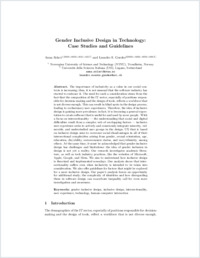Gender inclusive design in technology : case studies and guidelines
- Szlavi, Anna ORCID Norwegian University of Science and Technology (NTNU), Trondheim, Norway
- Soares Guedes, Leandro ORCID Istituto Dalle Molle di studi sull'intelligenza artificiale (IDSIA), Facoltà di scienze informatiche, Università della Svizzera italiana, Svizzera
- 2023
Published in:
- Design, User Experience, and Usability (HCII). - 2023, p. 343–354
Gender inclusive design
Inclusive design
Intersectionality
User experience
Technology
Human-computer interaction
English
The importance of inclusivity as a value in our social contexts is increasing; thus, it is not unusual that the software industry has started to embrace it. The need for such a consideration stems from the fact that the composition of the IT sector, especially of positions responsible for decision-making and the design of tools, reflects a workforce that is not diverse enough. This can result in blind spots in the design process, leading to exclusionary user experiences. Therefore, the idea of inclusive design is gaining more prevalence; in fact, it is becoming a general expectation to create software that is useful for and used by more people. With a focus on intersectionality - the understanding that social and digital difficulties result from a complex web of overlapping factors - inclusive user experience seeks to actively and consciously integrate minority, vulnerable, and understudied user groups in the design. UX that is based on inclusive design aims to overcome social disadvantages in all of their intersectional complexities arising from gender, sexual orientation, age, education, dis/ability, socioeconomic status, and race/ethnicity, among others. At the same time, it must be acknowledged that gender-inclusive design has challenges and limitations: the idea of gender inclusion in design is not yet a reality. Our research investigates academic literature, as well as tech industry practices, like the websites of Microsoft, Apple, Google, and Meta. We aim to understand how inclusive design is theorized and implemented nowadays. Our analysis shows that intersectionality suffers even when inclusivity is intended to be taken into consideration. We also offer guidelines for factors that might be explored for a more inclusive design. Our paper’s analysis leaves an opportunity for additional study; the complexity of identities and how disregarding them in software design can exacerbate inequality call for even more investigation and awareness.
- Collections
- Language
-
- English
- Classification
- Computer science and technology
- License
-
License undefined
- Open access status
- green
- Identifiers
-
- DOI 10.1007/978-3-031-35699-5_25
- ARK ark:/12658/srd1328206
- Persistent URL
- https://n2t.net/ark:/12658/srd1328206
Statistics
Document views: 140
File downloads:
- SoaresGuedes_2023_HCIIa: 660
